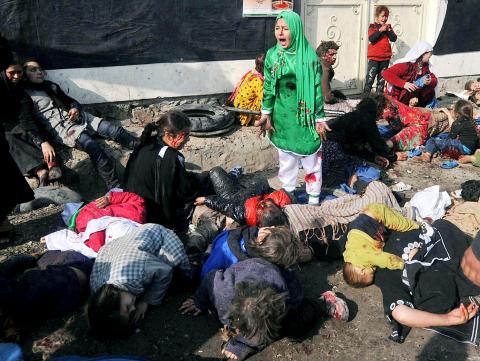Capture the Moment: The Pulitzer Prize Photographs, one of the most sought after exhibitions in the US, has been on tour for over a decade, and is currently making a rare visit to Asia, showing at a refurbished venue at Huashan 1914 (華山1914文創園區) until April 17, then moving on to Kaohsiung before returning to the US. The show encapsulates over half a century of history in iconic images that have reached deep into the heart of humanity.
At the heart of the exhibition is Cyma Rubin, who created the exhibition in 2000, and was in Taipei this week to oversee the setup of the show, which now features over 151 photos dating from the establishment of the Pulitzer Prize for photography in 1942.
The exhibition has toured around the US, with occasional visits overseas for more than 10 years.

Photo courtesy of Agence France-Presse
“It grows every year,” Rubin said, explaining that the photos are now taken from the two categories for which the Pulitzer for photography is awarded: the original award for what was essentially spot news (designated as Breaking News), and a second for feature photography, a category established in 1968. The award winners are selected from nominations taken from photos published in a US newspaper, many of them then subsequently seen in newspapers around the world. Some of the images, such as Old Glory Goes Up on Mt Suribachi by Associated Press photojournalist Joe Rosenthal, have become indelible icons of the media age.
While many of the photos necessarily deal with US subjects, taken by American journalists, it is not exclusively so. Last year’s winner, Massoud Hossaini, working for Agence France-Presse, won with Attack in Kabul, a chance photo taken after a bloodbath that took place during a festival in Kabul. Wounded himself by an explosion that ripped through a crowd during a Muslim holiday, Hossaini snapped a shot of a young girl, screaming in terror, wearing a brand new tunic, her family dead around her. Hossaini’s photo ran on front pages around the world, and according to Rubin, the photographer, who was himself born in Afghanistan, wept for days.
An element that provides additional interest to the exhibition is the fact that Rubin includes a short text telling the story of how the shot came to be taken, often with quotes from the photographers. Patrick Farrell’s photos from the village of Cabaret in Haiti following the devastation of Hurricane Ike were such graphic images of despair that Rubin tells us that they set off “an intense debate among newspaper editors over whether to publish the photos.” Looking at the images, blown up so that viewers can appreciate all the fine detail, it is not difficult to see why.

Photo courtesy of Des Moines Register
Rubin said it took her four years to collect the material for this exhibition, as the negatives for many of the photos were not located in a single archive.
“I went to Columbia, and went to the [Pulitzer] archives. … When I got up there, there was no archive, just a closet with some pictures thrown around. We needed to find the photographers, find the negatives … negatives that had basically been lost,” Rubin said.
Although Rubin has been working with Capture the Moment for over a decade, she says that in looking at the photos she “sees new things all the time. … I never feel they are dated, I never feel they are boring, even though I intimately know the stories. You just look at them ... those moments that were captured, those still images will never change.”

Photo courtesy of Steve Ludlum

Photo courtesy of Ken Geiger and The Dallas Morning News

Photo courtesy of Rocco Morabito

May 18 to May 24 Pastor Yang Hsu’s (楊煦) congregation was shocked upon seeing the land he chose to build his orphanage. It was surrounded by mountains on three sides, and the only way to access it was to cross a river by foot. The soil was poor due to runoff, and large rocks strewn across the plot prevented much from growing. In addition, there was no running water or electricity. But it was all Yang could afford. He and his Indigenous Atayal wife Lin Feng-ying (林鳳英) had already been caring for 24 orphans in their home, and they were in

On May 2, Chinese Nationalist Party (KMT) Chairman Eric Chu (朱立倫), at a meeting in support of Taipei city councilors at party headquarters, compared President William Lai (賴清德) to Hitler. Chu claimed that unlike any other democracy worldwide in history, no other leader was rooting out opposing parties like Lai and the Democratic Progressive Party (DPP). That his statements are wildly inaccurate was not the point. It was a rallying cry, not a history lesson. This was intentional to provoke the international diplomatic community into a response, which was promptly provided. Both the German and Israeli offices issued statements on Facebook

Even by the standards of Ukraine’s International Legion, which comprises volunteers from over 55 countries, Han has an unusual backstory. Born in Taichung, he grew up in Costa Rica — then one of Taiwan’s diplomatic allies — where a relative worked for the embassy. After attending an American international high school in San Jose, Costa Rica’s capital, Han — who prefers to use only his given name for OPSEC (operations security) reasons — moved to the US in his teens. He attended Penn State University before returning to Taiwan to work in the semiconductor industry in Kaohsiung, where he

President William Lai (賴清德) yesterday delivered an address marking the first anniversary of his presidency. In the speech, Lai affirmed Taiwan’s global role in technology, trade and security. He announced economic and national security initiatives, and emphasized democratic values and cross-party cooperation. The following is the full text of his speech: Yesterday, outside of Beida Elementary School in New Taipei City’s Sanxia District (三峽), there was a major traffic accident that, sadly, claimed several lives and resulted in multiple injuries. The Executive Yuan immediately formed a task force, and last night I personally visited the victims in hospital. Central government agencies and the